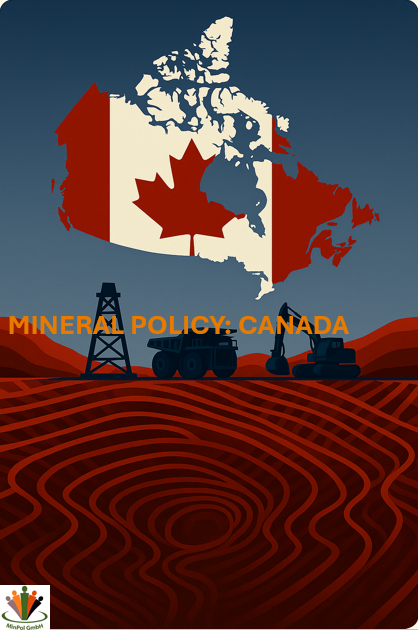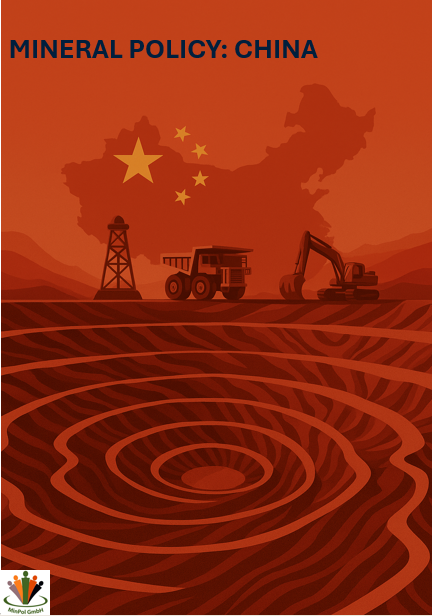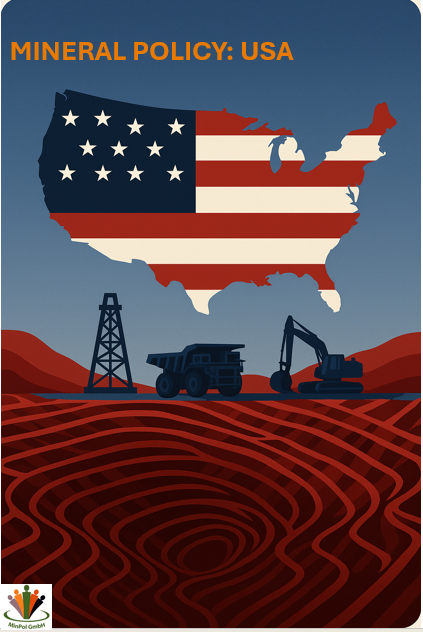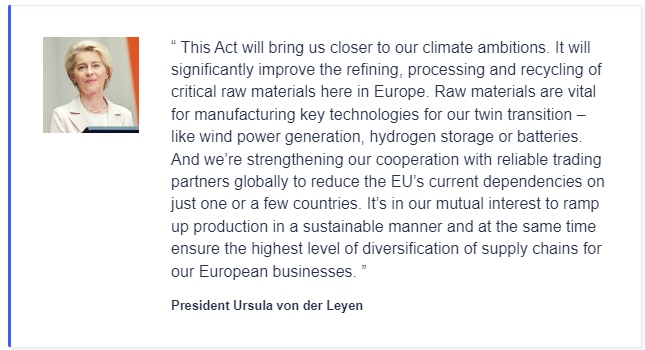Oct 25, 2025
Australia stands at the heart of the global critical minerals transition — and the MINRIS Australia Mineral Policy Report delivers an in-depth exploration of how this resource-rich nation is reshaping its mining laws, investment frameworks, and international partnerships to meet the moment.
Now available for purchase, this report unpacks the policies, laws, and strategies driving Australia’s critical minerals sector — a cornerstone of both its domestic economy and global decarbonisation ambitions.
Table of Content
Introduction
1.1 General
1.2 Structure of the Report
1.3 Mineral Economy of Australia
Policy Framework
2.1 Australian Government Policy Towards Mining and International Investment
2.2 Critical Minerals Strategy and National Initiatives
2.3 Recent Political Developments Affecting the Mining Industry
2.4 Restrictions on Foreign Investment
Legal Framework
3.1 Legal System
3.2 Ownership of Minerals
3.2.1 Rights to Use Surface of Land
3.2.2 Foreign and Indigenous Ownership Requirements and Restrictions
3.3 Basic Law
3.3.1 Mineral Resources (Sustainable Development) Act 1990
3.3.2 Mining Act 1978 (Western Australia)
3.3.3 Offshore Minerals Act 1994
3.4 Other Relevant Legislation
Responsible Ministries and Authorities
Permitting Procedure
5.1 Overview
5.2 Exploration
5.2.1 Terms and Conditions of Exploration Licences
5.2.2 Obligations of Licence Holders
5.3 Mining
5.3.1 Mining Leases and Tenements
5.3.2 Processing, Refining, and Export Controls
5.4 Environmental and Indigenous Consultation Requirements
5.5 Royalties, Taxes, and Financial Instruments
Mining Cadastre and Data Systems
Mineral Resource Potential
List of Critical Minerals References
Contact and Institutional Framework
9.1 Federal Government Departments
9.2 State and Territory Authorities
9.3 Industry Associations and Advocacy Platforms
Summary and Conclusion
References
Key Value Highlights
Australia’s Strategic Role in the Global Critical Minerals Ecosystem
The report outlines how Canberra has positioned critical minerals at the centre of its economic and security agenda.
Through the Critical Minerals Strategy (2023–2030), Australia aims to not just extract but process, refine, and supply key materials — lithium, rare earths, nickel, cobalt, and vanadium — vital to global clean energy, defence, and high-tech manufacturing.
Investor Certainty through Legal and Fiscal Stability
Australia’s legal system offers some of the world’s most secure frameworks for mineral ownership and licensing.
The report details how state-based mining acts — such as the Mining Act 1978 (WA) and Mineral Resources (Sustainable Development) Act 1990 (VIC) — underpin regulatory clarity and consistent permitting. Royalties and taxation regimes are predictable, making Australia a top-tier destination for international investment.
Environmental Stewardship and Indigenous Engagement
Australia continues to balance economic opportunity with environmental and social accountability.
The report examines the evolving integration of ESG standards, native title frameworks, and rehabilitation obligations — ensuring that mining growth aligns with sustainability and community benefit.
Partnerships Driving Downstream Value
With the U.S., Japan, India, and the EU seeking to diversify supply chains, Australia’s policy is shifting from “dig and ship” to value-add and collaborate.
The report highlights federal incentives through programs like the Northern Australia Infrastructure Facility and Critical Minerals Facility, which support domestic processing projects and cross-border strategic partnerships.
Data Transparency and Modern Cadastre Systems
Australia’s Mining Cadastre and Geoscience Data Portals (e.g., Geoscience Australia and AUSGIN) are showcased as global benchmarks for transparency, accessibility, and investor confidence — key enablers for exploration and regulatory efficiency.
Why This Report Matters
For policymakers, it decodes how Australia’s mineral policy framework is balancing security, sustainability, and economic competitiveness.
For investors, it identifies which minerals, jurisdictions, and incentives are poised to define the next decade of Australian mining.
For industry stakeholders, it serves as a roadmap to navigate permitting, ESG compliance, and partnership development across Australia’s federated governance system.
Invest strategically. Develop sustainably. Partner globally.
The MINRIS Australia Mineral Policy Report 2025 is your essential guide to understanding how the world’s leading mining nation is evolving to meet the critical minerals challenge — and shaping the future of secure, responsible resource supply.
Associate Prof. Dr. Guenter Tiess is managing director of MinPol, Agency for international Mineral Policy. MinPol is also running an international network of experts of every branch in the field of minerals policy that is continuously growing. The network is already by now covering almost all continents, which emphasises the world-wide approach of MinPol. An economy geologist by training (PhD, Habilitation), he has more than fifteen years of experience in research on focused on international mineral policy, mining and sustainability.
Please visit http://www.minpol.com/references.html for relevant projects and published reports.
Aug 3, 2025
From fragmented data to global clarity — the new era of mining intelligence has arrived.
- Mining policy isn’t what it used to be. Across the globe, governments are recalibrating their stance on strategic minerals — tightening controls, rewriting tax codes, reshaping permitting timelines, and rethinking the role of foreign investment. From the lithium triangle of South America to the graphite fields of Africa and the battery corridors of Southeast Asia, the rules of the game are changing.
Yet most mineral policy data remains siloed, outdated, and scattered — locked in government PDFs, buried in legalese, or fragmented across news reports.
MINRIS changes that.
One Platform. Every Jurisdiction. Unmatched Depth.
Introducing the Global Mineral Policy Review (GMPR) — MINRIS’ flagship annual publication and the world’s most comprehensive guide to mining policy, law, and investment intelligence.
Covering over 160 countries, GMPR offers a sweeping, standardized analysis of global mineral governance — distilling thousands of pages of regulatory text, policy updates, and legal frameworks into a single, coherent, and actionable resource.
Table of Contents
Introduction
Special feature of the report
Overview of the report
List of regions with national policies
• Africa
• Asia and Pacific
• Europe
• North America
• Latin America and Caribbean
• Oceania
List of references
This is not a surface-level snapshot. It’s a deep dive into:
- National mineral strategies & critical raw material lists
- Licensing and permitting regimes
- Investment incentives and foreign ownership rules
- Environmental and social regulations
- Royalties, taxation, and fiscal frameworks
- Trade restrictions and export controls
- ESG and decarbonization pathways in mining
Whether you’re an investor evaluating jurisdictional risk, a policymaker benchmarking reform, or a supply chain strategist navigating new critical mineral sourcing, GMPR provides the clarity to move forward with confidence.
The Intelligence Behind the Headlines
For years, stakeholders have navigated mining landscapes with limited visibility. But the stakes are now higher — and the policy signals more complex:
- Indonesia’s evolving downstream mandates
- Chile’s debate on state control of lithium
- The EU’s Critical Raw Materials Act enforcement
- Canada’s screening of foreign investments in key minerals
- India’s production-linked incentives for battery metals
In isolation, these stories offer insight. But in comparison, they reveal the broader arc of global mineral geopolitics. That’s what GMPR delivers: comparative context and strategic foresight.
Standardized for Strategic Decisions
Each country profile follows a structured template, enabling easy side-by-side comparisons across regions. Key metrics, summaries, and red flags are clearly flagged — with direct links to source legislation and official documents.
- Need to know how fast an exploration license is issued in Morocco vs. Western Australia?
- Want to compare royalty rates in Brazil, Namibia, and Kazakhstan?
- Wondering where Indigenous consultation is mandatory for permitting?
Our global mineral policy report gives you the answers — instantly.
Your Competitive Edge in a Critical Decade
The next decade will define who controls the mineral resources powering clean energy, defense, AI, and digital economies. For those investing in this transition — from private capital to public agencies — policy risk is now investment risk. The Global Mineral Policy Review doesn’t just report on the terrain. It maps it.
What’s Inside:
- 160+ country profiles
- Regional comparative indices
- Risk mapping
- Exclusive commentary from policymakers, investors, and legal experts
Associate Prof. Dr. Guenter Tiess is managing director of MinPol, Agency for international Mineral Policy. MinPol is also running an international network of experts of every branch in the field of minerals policy that is continuously growing. The network is already by now covering almost all continents, which emphasises the world-wide approach of MinPol. An economy geologist by training (PhD, Habilitation), he has more than fifteen years of experience in research on focused on international mineral policy, mining and sustainability.
Please visit http://www.minpol.com/references.html for relevant projects and published reports.
Jun 8, 2025
From coast to coast, Canada is emerging as one of the world’s most strategic and responsible suppliers of critical minerals. As global demand for clean energy technologies, EVs, and secure supply chains hits unprecedented levels, the Canada Mineral Policy Report 2025 is your definitive guide to understanding where Canada stands—and where it’s going.
This is not just a report. It’s a launchpad for investment, policy foresight, and strategic engagement in one of the most important sectors of the 21st-century economy.
Available for purchase
Table of Content
1. Introduction
1.1 General
1.2 Structure of the Report
1.3 Mineral Economy
2. Policy Framework
2.1 General
2.2 Canadian Minerals and Metals Policy
2.3 Canadian Critical Minerals Strategy
2.4 Recent Political Developments
2.5 Foreign Investor Benefits and Restrictions
2.6 International Treaties Related to Exploration and Mining
3. Legal Framework
3.1 Legal System
3.2 Ownership of Minerals
3.2.1 Title (Ownership)
3.2.2 Nature of Mineral Rights
3.2.3 Rights to Use Surface of Land
3.2.4 Indigenous Ownership Requirements and Restrictions
3.3 Basic Law
3.4 Other Law
4. Responsible Ministry
5. Permitting Procedure
5.1 Overview
5.2 Mining Rights and Required Licences and Permits
5.2.1 Granting of Mineral Rights
5.3 Prospecting and Exploration
5.3.1 Prospecting Right Requirements
5.3.2 Exploration
5.4 Mining Lease
5.5 Security over Mining Tenements and Related Assets
5.6 Dealing in Rights by Means of Transferring
5.7 Cancellation, Abandonment and Relinquishment
5.8 Operations, Processing and Sale of Minerals
5.9 Environmental and Social Considerations
5.9.1 Environmental Authorisations to Conduct Exploration and Mining Operations
5.9.2 Impact of Environmental Protection and Community Relations on Mining Projects
5.9.3 Environmental, Social and Governance (ESG) Guidelines and Regulations
5.9.4 Provisions Regarding Storage of Tailings
5.9.5 Closure Obligations of the Holder of an Exploration Right or Mining Right
5.9.6 Zoning or Planning Requirements for the Exercise of an Exploration or Mining Right
5.10 Royalties and Taxes
5.10.1 Other Fees
5.10.2 Tax Incentives for Mining Investors and Projects
5.10.3 Transfer Tax and Capital Gains on the Sale of Mining Projects
5.11 Mining Finance: Granting and Perfecting Security
6. Mining Cadastre
7. Mineral Resource Potential
8. List of Critical Minerals References
9. Contact of Stakeholders
9.1 Overview
9.2 Description of Stakeholders
9.2.1 Federal Government of Canada
9.2.2 Authorities
9.2.3 Advocates
9.2.4 Security Platforms
9.2.5 Mining Platforms
10. Summary and Conclusion
11. References
🍁 What Makes This Report Essential?
1. Canada’s $4B Critical Minerals Strategy, Decoded
Backed by nearly CAD $4 billion in federal funding, Canada’s updated Critical Minerals Strategy is an aggressive, full-spectrum plan—from exploration to recycling. The report provides in-depth analysis of its six priority minerals (lithium, graphite, nickel, cobalt, copper, and rare earths), and how they align with global supply chain needs.
2. The World’s Most Investable Mining Jurisdiction?
Consistently ranked among the top global destinations for mining investment, Canada offers what few others can: rich geology, world-class governance, investor protections, and Indigenous partnerships. The report walks you through provincial incentives, permitting advantages, and why Toronto and Vancouver remain global mining finance capitals.
3. A Model for ESG-Driven Mining
With leading frameworks like TSM (Towards Sustainable Mining), Canada sets a global benchmark for responsible development. The report outlines how ESG performance is being institutionalized—from impact assessments to Indigenous inclusion, mine closure obligations, and green infrastructure standards.
4. International Partnerships That Matter
Whether it’s the Canada-U.S. Critical Minerals Action Plan, EU agreements, or G7 coordination, the report details how Canada is expanding its global footprint as a secure and sustainable supplier. It also breaks down the new bilateral rules shaping trade, investment flows, and value-added processing.
5. A Province-by-Province Breakdown of Opportunity
From Québec’s battery corridor to BC’s newly launched Critical Minerals Strategy, and Ontario’s Innovation Fund for strategic metals, the report maps Canada’s internal competitive landscape—so you know where to look, and where to invest.
Who Should Read This Report?
- Investors & Analysts – Spot low-risk, high-return mining and midstream projects with a globally trusted partner.
- Government Agencies & Trade Bodies – Benchmark policy design, regulatory agility, and investment strategy.
- OEMs & Clean Tech Leaders – Align your procurement with traceable, ethical, and trade-compliant mineral sources.
- ESG, Legal & Compliance Professionals – Stay ahead of fast-evolving environmental and Indigenous engagement requirements.
Why It Matters:
Canada isn’t just producing minerals—it’s exporting certainty.
In a fractured geopolitical landscape, Canada offers what markets crave: stability, scale, and standards. The Canada Mineral Policy Report 2025 is your front-row seat to a nation that’s redefining how critical minerals are sourced, governed, and shared with the world.
🧭 Secure your copy. Position your strategy. Partner with purpose.

Associate Prof. Dr. Guenter Tiess is managing director of MinPol, Agency for international Mineral Policy. MinPol is also running an international network of experts of every branch in the field of minerals policy that is continuously growing. The network is already by now covering almost all continents, which emphasises the world-wide approach of MinPol. An economy geologist by training (PhD, Habilitation), he has more than fifteen years of experience in research on focused on international mineral policy, mining and sustainability.
Please visit http://www.minpol.com/references.html for relevant projects and published reports.
Jun 8, 2025
As the global race for critical minerals accelerates, nowhere is the strategic calculus more complex—or more consequential—than in China. The China Mineral Policy Report 2025 offers a rare, comprehensive lens into the world’s leading producer of rare earths and a key architect of global mineral supply chains. For policymakers, investors, and mining sector stakeholders, this report is not just timely—it’s indispensable.
Available for purchase
Why This Report Matters Now
China’s grip on critical mineral markets—from rare earths to lithium, cobalt, and germanium—is both a geopolitical asset and a policy fulcrum. In 2025, this grip is tightening through domestic reforms, foreign investment restrictions, expanded state-led exploration, and the strategic use of export controls. The China Mineral Policy Report 2025 unpacks these dynamics in detail—giving you a front-row seat to the inner workings of China’s mineral policy engine.
Table of Content
1. Introduction
1.1 General
1.2 Structure of the Report
1.3 Mineral Economy of China
2. Policy Framework
2.1 China’s Policy on Mineral Resources
2.1.1 Critical Minerals Policy
2.2 Efforts to Push Forward an Open-Door Policy
2.3 Recent Policy Development
2.4 Restrictions on Foreign Investment
3. Legal Framework
3.1 Legal Systems
3.2 Ownership of Minerals
3.3 Basic Law
3.4 Other Sources of Law Affecting the Mining Industry
4. Responsible Ministry
5. Permitting Procedure
5.1 Overview
5.2 General Requirements for Setting Up a Mine
5.3 Exploration License
5.3.1 Entitlement of an Exploration License Holder
5.3.2 Duration
5.3.3 Relationship with Landowners
5.3.4 Obligations of the Exploration License Holder
5.3.5 Transition from Exploration Right to Mining Right
5.4 Mining License
5.4.1 Entitlement of a Mining License Holder
5.4.2 Duration
5.4.3 Obligations of the Mining License Holder
5.4.4 Additional Permits and Licenses
5.5 Transfer of Mineral Licenses
5.6 Indigenous and Local Community Rights
5.7 Processing, Refining, and Beneficiation
5.8 Environmental Protection and Rehabilitation Obligations
5.8.1 Environmental Impact Assessment
5.8.2 Provisions Regarding Storage of Tailings
5.8.3 Closure Obligations
5.8.4 Social Responsibility Requirements
5.8.5 Liabilities of a Mining Company
5.9 Royalties and Taxes
5.10 Financing of Mines – Asset Security
5.11 Foreign Investors
6. Mining Cadastre
7. Mineral Resource Potential
8. List of Chinese Critical Minerals References
9. Contact of Stakeholders
🔍 Inside the Report: What You’ll Discover
1. A National Mineral Security Campaign in Full Force
China has launched its most ambitious mineral prospecting drive in decades—focusing on securing domestic supply of strategic minerals in short supply. The report reveals how provinces like Xinjiang have increased exploration spending by over 300%, and how state subsidies are reshaping the exploration landscape.
2. Legal and Policy Instruments That Redraw the Map
From the revised Mineral Resources Law (effective July 2025) to environmental mandates for green mine development, this report tracks the critical reforms reshaping China’s mineral governance. You’ll gain an insider’s view of how permitting, tenure, foreign investment limits, and environmental obligations are evolving.
3. Export Controls as Strategic Leverage
China’s December 2024 and April 2025 export restrictions—targeting the U.S. and key global consumers—are more than a retaliatory measure. They are a signal: China is weaponizing its control over mineral chokepoints. The report outlines which minerals are targeted, what sectors are affected, and what global stakeholders should expect next.
4. Global Reach: China’s Investment Footprint Abroad
This isn’t just a domestic story. The report details China’s outbound investments across Africa, South America, Southeast Asia, and Central Asia—mapping where and how Chinese capital is securing lithium, cobalt, nickel, and rare earth supplies. For Western investors and governments, understanding China’s positioning is vital to crafting alternative supply chains.
5. The Rise of the “Green Mine” in a Politicized Landscape
China’s push toward eco-conscious mining isn’t merely about ESG—it’s about controlling the global narrative. Through national standards and strict monitoring, China is branding itself as a leader in responsible mining, even as it consolidates regulatory control. The report explores the implications for international competition and compliance benchmarking.
Who Is This Report For?
- Policymakers & Strategic Analysts – Understand China’s mineral playbook to inform your country’s industrial policy or strategic reserves.
- Mining & Energy Investors – Gain clarity on risk, opportunity, and regulation in China’s critical minerals ecosystem.
- Supply Chain Managers & OEMs – Navigate evolving trade dynamics and sourcing constraints with expert insight.
- Environmental & Compliance Professionals – Benchmark your sustainability strategy against China’s shifting regulatory landscape.
Conclusion:
China is not just a supplier—it’s a strategist.
In a world defined by mineral interdependence and geopolitical fragmentation, the China Mineral Policy Report 2025 equips you with the intelligence to act, hedge, invest, or respond. Don’t navigate blind. Arm your strategy with the most detailed, commercially actionable view of China’s mineral future.
📘 Get the report today—and get ahead of the curve.

Associate Prof. Dr. Guenter Tiess is managing director of MinPol, Agency for international Mineral Policy. MinPol is also running an international network of experts of every branch in the field of minerals policy that is continuously growing. The network is already by now covering almost all continents, which emphasises the world-wide approach of MinPol. An economy geologist by training (PhD, Habilitation), he has more than fifteen years of experience in research on focused on international mineral policy, mining and sustainability.
Please visit http://www.minpol.com/references.html for relevant projects and published reports.
Jun 8, 2025
MINRIS U.S. Mineral Policy Report offers deep insights into America’s evolving approach to critical minerals—a cornerstone of economic security, clean energy transition, and technological leadership.
Available now for purchase
This report is essential reading for policymakers shaping national strategy, investors targeting high-growth mineral assets, and industry stakeholders navigating the complex U.S. regulatory landscape. It delivers timely, actionable intelligence on how the United States is responding to geopolitical tensions, reshaping its mining laws, and catalyzing domestic critical mineral supply chains.
Table of Content
-
Introduction
1.1 General
1.2 Mineral Economy
-
Policy Framework
2.1 Government Policy towards Mining and International Investment
2.2 Critical Minerals
2.3 Recent Political Developments Affecting the Mining Industry
2.4 Restrictions on Foreign Investment
-
Legal Framework
3.1 Legal System
3.2 Ownership of Minerals
3.2.1 Rights to Use Surface of Land
3.2.2 Foreign Ownership and Indigenous Ownership Requirements and Restrictions
3.3 Basic Law
3.3.1 Federal Land Policy and Management Act of 1976
3.3.2 General Mining Law of 1872
3.3.3 Mineral Lands Leasing Act of 1920
3.3.4 Materials Disposal Act of 1947
3.4 Other Law
-
Responsible Ministry
-
Permitting Procedure
5.1 Overview
5.2 Exploration
5.2.1 General
5.2.2 Terms of Rights
5.2.3 Obligations of the Holder
5.3 Mining
5.3.1 Tenements / Rights Available
5.3.2 Additional Permits and Licenses
5.4 Processing, Refining, Beneficiation, and Export
5.5 Dealing in Rights by Means of Transferring
5.6 Cancellation, Abandonment, and Relinquishment
5.7 Indigenous or Local Community Rights
5.8 Environmental
5.8.1 Environmental Authorisations Regarding Exploration and Mining
5.8.2 Social Responsibility Requirements under Applicable Law
5.8.3 Closure and Remediation of Mining Projects
5.9 Taxes and Royalties
5.10 Mining Finance: Granting and Perfecting Security
5.11 Foreign Investment
-
Mining Cadastre
-
Mineral Resource Potential
-
List of U.S. Critical Minerals References
-
Contact
9.1 Congress
9.2 Government
9.3 Agencies
9.3.1 EPA
9.3.2 USGS
9.4 Advocates
9.4.1 Mayer Brown LLP
9.4.2 Holland & Hart LLP
9.4.3 Baker McKenzie
9.5 Mining Platforms
9.5.1 American Critical Minerals Association (ACMA)
9.5.2 U.S. Critical Materials Corp.
9.5.3 Critical Minerals Subcommittee (CMS)
9.5.4 The USA Leaders
9.5.5 U.S. Mining Industry
-
Summary and Conclusion
-
References
Key Value Highlights:
- Strategic Clarity on Critical Minerals
With over 50 designated critical minerals including lithium, rare earth elements, and graphite, the U.S. is aggressively restructuring its policy framework to reduce import reliance—particularly on adversarial suppliers. The report maps how Executive Orders, the Energy Act of 2020, and the Inflation Reduction Act are transforming critical mineral development into a national security priority.
- New Opportunities in Domestic Mining
The report identifies how new permitting reforms, tax credits (e.g. Section 45X), and Defense Production Act incentives are creating unparalleled openings for exploration and processing within U.S. borders. It spotlights the sectors and geographies most primed for investment and fast-tracked development.
- Regulatory Roadmaps & Investment Signals
From the overhaul of the General Mining Law to the expansion of the “Foreign Entity of Concern” rules, this report clarifies the legal terrain and de-risks decision-making. Investors gain a clear view of how to qualify for federal incentives, while mining companies get practical guidance for securing permits, licenses, and community buy-in.
- U.S. Response to China’s Market Dominance
This edition includes a focused analysis of China’s escalating export controls on rare earths and strategic materials—and how the U.S. is countering through new Critical Minerals Agreements (e.g. Japan), federal stockpiling strategies, and expanded international partnerships.
- Data-Driven Decision Support
With integrated policy analysis, legal frameworks, and mineral market trends, the report equips buyers with the foresight to align their strategies with U.S. government priorities and international supply chain shifts.
Why Buy This Report?
This is not just a policy overview—it is a strategic toolkit. Whether you’re making decisions in Washington or Wall Street, Denver or downstream in Detroit, this report positions you at the intersection of security, sustainability, and market opportunity.
Invest confidently. Regulate smartly. Mine responsibly.
The U.S. Mineral Policy Report 2025 is your edge in the global critical minerals race.

Associate Prof. Dr. Guenter Tiess is managing director of MinPol, Agency for international Mineral Policy. MinPol is also running an international network of experts of every branch in the field of minerals policy that is continuously growing. The network is already by now covering almost all continents, which emphasises the world-wide approach of MinPol. An economy geologist by training (PhD, Habilitation), he has more than fifteen years of experience in research on focused on international mineral policy, mining and sustainability.
Please visit http://www.minpol.com/references.html for relevant projects and published reports.
Nov 10, 2024

The Critical Raw Materials Act will equip the EU with the tools to ensure the EU’s access to a secure and sustainable supply of critical raw materials, mainly through:
Setting clear priorities for action: In addition to an updated list of critical raw materials, the Act identifies a list of strategic raw materials, which are crucial to technologies important to Europe’s green and digital ambitions and for defence and space applications, while being subject to potential supply risks in the future. The Regulation embeds both the critical and strategic raw materials lists in EU law. The Regulation sets clear benchmarks for domestic capacities along the strategic raw material supply chain and to diversify EU supply by 2030:
- At least 10% of the EU’s annual consumption for extraction,
- At least 40% of the EU’s annual consumption for processing,
- At least 15% of the EU’s annual consumption for recycling,
- Not more than 65% of the Union’s annual consumption of each strategic raw material at any relevant stage of processing from a single third country.
Creating secure and resilient EU critical raw materials supply chains: The Act will reduce the administrative burden and simplify permitting procedures for critical raw materials projects in the EU. In addition, selected Strategic Projects will benefit from support for access to finance and shorter permitting timeframes (24 months for extraction permits and 12 months for processing and recycling permits). Member States will also have to develop national programmes for exploring geological resources.
Ensuring that the EU can mitigate supply risks: To ensure resilience of the supply chains, the Act provides for the monitoring of critical raw materials supply chains, and the coordination of strategic raw materials stocks among Member States. Certain large companies will have to perform an audit of their strategic raw materials supply chains, comprising a company-level stress test.
Investing in research, innovation and skills: The Commission will strengthen the uptake and deployment of breakthrough technologies in critical raw materials. Furthermore, the establishment of a large-scale skills partnership on critical raw materials and of a Raw Materials Academy will promote skills relevant to the workforce in critical raw materials supply chains. Externally, the Global Gateway will be used as a vehicle to assist partner countries in developing their own extraction and processing capacities, including skills development.
Protecting the environment by improving circularity and sustainability of critical raw materials: Improved security and affordability of critical raw materials supplies must go hand in hand with increased efforts to mitigate any adverse impacts, both within the EU and in third countries with respect to labour rights, human rights and environmental protection. Efforts to improve sustainable development of critical raw materials value chains will also help promoting economic development in third countries and also sustainability governance, human rights, conflict-resolution and regional stability.
Member States will need to adopt and implement national measures to improve the collection of critical raw materials rich waste and ensure its recycling into secondary critical raw materials. Member States and private operators will have to investigate the potential for recovery of critical raw materials from extractive waste in current mining activities but also from historical mining waste sites. Products containing permanent magnets will need to meet circularity requirements and provide information on the recyclability and recycled content.





Recent Comments